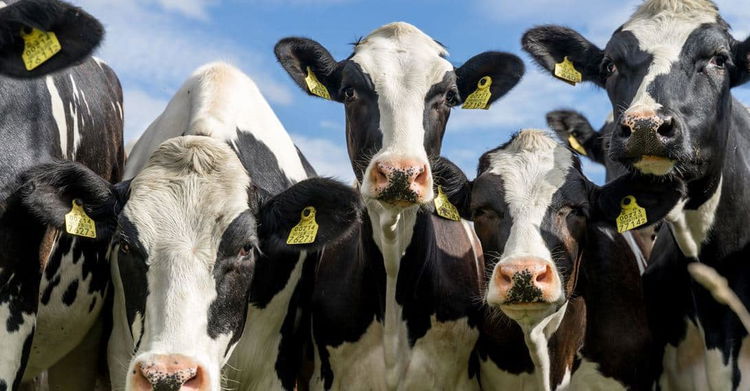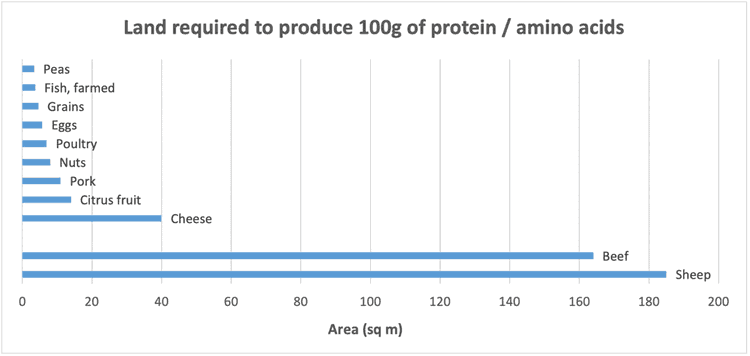Most livestock land will have to be repurposed as carbon sinks to remove the huge global emissions related to food production.

The COP26 debates often ignored the cow in the room—the biggest challenge of all. Greenhouse gases (GHG) from food and agriculture comprise a third of global emissions. Success in stemming climate change hinges emphatically on reducing food-chain emissions to zero. That can only occur with dietary changes, accompanied by repurposing as carbon sinks most agricultural lands feeding beef and dairy cattle.
Achieving zero emissions from all sectors, except food, is potentially amenable to technology. Replacing fossil fuels in long-distance air and marine travel, production of cement clinker and some chemical and industrial processes will be challenging. But the associated research and development is advancing and eliminating emissions without sacrificing quality of life appears technically feasible.
Volkswagen, for instance, is powering its huge new car-carrier vessels with waste and residual vegetable oils. Maersk has ordered eight giant ships, each holding 16,000 containers, to be fuelled with carbon-neutral methanol. Steel at the largest electricity consumer in Colorado (arc furnaces at Evraz Rocky Mountain Steel) is being produced with solar energy. And Deutsche Bahn is experimenting with French hydrogen-fuelled locomotives and lithium-ion batteries to replace diesel.
Huge impediment
The food chain is different, however. Fossil fuels account for only 20 per cent of sector emissions. And most food-chain emissions—from crop fertilisation, ploughing, rice paddies, animals burping methane and the like—can only be marginally attenuated. Improved manure management, planting more nitrogen-fixing legumes and switching to green fertiliser from solar-electrolysis hydrogen are promising. But burping by beef and dairy cattle alone accounts for 8 per cent of global GHG emissions (with mitigation hinging on exotic R&D options, such as seaweed feed additives).
Food-chain (>26 per cent) and non-food agricultural uses (>5 per cent), such as textiles, sum to 31-34 per cent of global GHG emissions. They still account for a quarter of net emissions after adjusting for estimated emission offsets (photosynthesis and land carbon fluxes) that capture atmospheric GHG. That 25 per cent is a huge impediment to zero emissions.
The first step is to identify foods high in emissions—overwhelmingly animal products.

Meat is not an indispensable source of protein, as more than a billion vegetarians worldwide attest. Fish and vegetables such as peas already supply 63 per cent of global proteins / amino acids. Protein substitutes for milk, other dairy and meat are rapidly gaining market acceptance.
As sources of protein / amino acids, vegetables are far more environmentally sustainable. These data are the scientific basis for appeals to reduce meat and dairy consumption. (A spinoff benefit is reducing the spread of bacterial resistance in humans by corralling antibiotic use in animals.)
Switching to low-emission foods alone will not however eliminate food and agriculture’s 25 per cent global net share. If all consumers worldwide excluded beef and cow products from their diets, this would eliminate only 9 per cent of emissions.
Carbon sinks
The gap can be largely closed with a second policy—repurposing as carbon sinks pastures and lands cultivating feed for large ruminants. Cattle and cows, for instance, eat about 25 pounds daily, their land requirements far exceeding that for smaller ruminants—sheep (4.5 pounds/day) and goats (2-4 pounds)—as well as fish, pork, poultry and plants.

Livestock pastures and cropland cultivating animal feed occupy 77 per cent of global agricultural land, with about three-quarters of that acreage devoted just to cattle and cows. Scientists calculate that allowing all livestock lands to revert to carbon sinks would result in the sequestration of 8.1 gigatons of GHG annually over the next 100 years. Converting the share devoted just to cattle and cows would sequester up to 6 gigatons annually, comparable to 12 per cent of global emissions. In combination with dietary substitution of plants and poultry for cattle and cows, that would close much of the food-chain emissions gap.
True, cultivation of the substitute low-emissions foods would add 2-3 percentage points to land-cropping requirements and thus to global emissions. Additional emissions reductions are however feasible from promising agricultural R&D and from cessation of deforestation in the Amazon, Indonesia and elsewhere associated with cattle (cleared for pastures and feed cultivation). Deforestation for cattle alone adds 3.4 per cent to annual GHG emissions.
Central to this environmentally beneficient scenario is purging most large-ruminant food products from diets; that is an environmental sine qua non. At the same time, selective accommodation is appropriate regarding some meat or dairy products and for the 500 million pastoralists and smallholders worldwide who depend on livestock for their survival, income and assets. Moreover, religious considerations are important, particularly in south Asia.
Land purchases
In the European Union, reforms to the Common Agriculture Policy set for 2023, just adopted by the Council of the EU, will likely shrink herd size. The CAP could complement those reforms with voluntary purchases of current cattle pastures to create publicly-owned carbon reserves. Safeguards could include animal censuses to ensure herds do shrink. Financed with meat taxes, such land purchases would ease (and perhaps accelerate) the transition of cattle owners and dairy farmers to other pursuits while creating new national parks and forests.
The same concept could be adopted in the United States if opposition can be overcome from Republican politicians seeking partisan advantage by embracing beef and from the meat and dairy industry. Reducing herds could be facilitated by creating carbon reserves, financed entirely by reallocating the annual $38 billion federal meat-and-dairy subsidy. Moreover, displaced cattle and dairy workers could be included in the American Jobs Plan of the president, Joe Biden, otherwise providing support for former fossil-fuel-industry workers. Occupational transition for the combined two million workers could include training to enhance re-employment, along with support for their communities.
A model is the 1977 expansion of California’s Redwood National Park, where Congress provided hefty income support over 6-11 years for displaced loggers. That model today could be funded in part by diverting the government’s annual $20 billion fossil-fuel subsidy.
Huge challenge
Reducing food-chain and agricultural emissions to zero is a huge challenge for a global industry with tens of millions of workers, 500 million pastoralists and herders, and nearly eight billion fickle consumers. Pivotal will be sweeping mitigation policies, including switching government and World Bank subsides from cattle to small-animal husbandry. Moreover, consumers need encouragement to remove large ruminants from diets—a goal taxes and R&D on benign substitutes for beef and cows can facilitate.
As COP26 and the recent report by the Intergovernmental Panel on Climate Change make clear, inaction is not an option. Without prompt reforms, the globe is certain to replay the Pliocene era of 3-5 million years ago—melted ice caps flooding the planet, with seas 82 feet higher, and relocation of 190-630 million flooded inhabitants.
George Tyler is a former US deputy Treasury assistant secretary and senior official at the World Bank. He is the author of What Went Wrong: How the 1% Hijacked the American Middle Class ... And What Other Nations Got Right.

